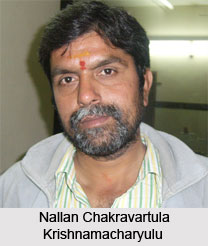 Sri Nallan Chakravartula Krishnamacharyulu, a great scholar, was born in the year 1924, was an exponent of art of Hari Katha of modern times. He also belongs to the linage of Saint Tyagaraja and is the 5th generation student descendant of the great saint.
Sri Nallan Chakravartula Krishnamacharyulu, a great scholar, was born in the year 1924, was an exponent of art of Hari Katha of modern times. He also belongs to the linage of Saint Tyagaraja and is the 5th generation student descendant of the great saint.
Life and Career of Nallan Chakravartula Krishnamacharyulu
Nallan Chakravartula Krishnamacharyulu was born in the year 1924 in Jaggayya Peta in the Indian state of Andhra Pradesh to Jagannaadha Tiru Venkataacharyulu and Venkata Ramanamma (his parents). At a very early age, Nallan Chakravartula Krishnamacharyulu started learning Vyaakarana and Meemaamsa Sastras from his father, and later from Sri Chilakamarri Kesavaacharyulu.
He also had a long Gurukulam style of training in the field of Carnatic music from the legendary Parupalli Rama Krishnayya Pantulu who is credited with producing such stalwarts as Dr. M. Balamuralikrishna and Annavarapu Rama Swamy.
Sri Krishnmacharyulu served as staff violinist in All India Radio, Vijayawada from 1948 to 1983. He was conferred with the title of Gaana Kala Prapuurna by the Anadhra Pradesh Sangeetha Academy. Various other institutions recognized his mastery of the art by conferring titles Sangeetha Saahitya Kalaa Nidhi, Hari Kadhaa Chuudamani and Sangeetha Kalaa Saagara.
In November 1998, he received special recognition from All India Radio (AIR) during Golden Jubilee celebrations; later he also received a similar award from Telugu University, Hyderabad.
Sri Krishnamacharylu created several scholarly works in Sanskrit literature and Telugu literature. He was of firm belief that there was no need for anyone to compose new keerthanas in Carnatic tradition as the Trinity`s compositions were matchless and would take a life time to learn even a few. But due to compulsion and requests from some musicians, he composed over 20 krithis, varnams and Tillanas in popular as well as rare ragas. Just like earlier Vaggeyakaras (spontaneous saintly composers), he never needed to think of the verses due to his extraordinary scholarship in Sanskrit language and Telugu language.
| Composition | Raga | Tala | Type | Language |
| gourI sukumArI sankara nArI | Vasantha | Adi | Kriti | Sanskrit |
| mAra jananIm AsRayE | Nataka Priya | Adi | Kriti | Sanskrit |
| Sri kanaka durgE | Kalyani | Adi | Kriti | Sanskrit |




















